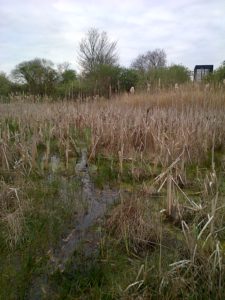The welcome chuntering of Reed Warblers could be heard once again at Thames Road Wetland on 18th April, my first visit since March 30th. There is obviously an advantage in making the effort to come all the way back to a small site like this, next to a noisy main road, from their wintering grounds in tropical Africa – but on a cool grey day it is not immediately apparent what that might be.
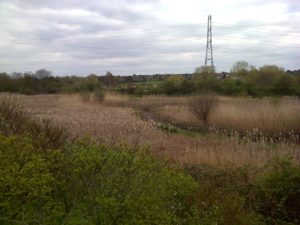
Thames Road Wetland, on an overcast 18th April 2016, is the summer home to migrants such as Reed Warbler and Whitethroat. (Photo: Chris Rose)
The ‘west pool’ where Reedmace is pulled every year to keep an area of shallow open water, was examined to assess the extent of re-growth from remaining rhizomes, and some of this was pulled, or cut out with a knife where necessary, so as to hold the plants in check for a while longer.
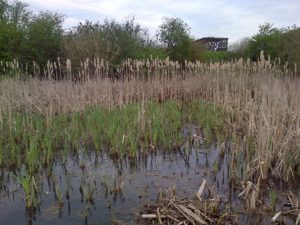
The lack of dead material in this shallow area indicates that Reedmace was pulled out over winter. Plenty of rhizome escapes removal, however, and the fresh green of new growth is very evident here, some of which is cut off to slow its comeback. (Photo: Chris Rose).
Common Reed has gradually got the upper hand in some areas, and for the first time at the site, an area of this was cut over the winter. Some of the significant amount of litter build up from fallen stem leaves was also removed, so as to help slow down the succession towards a higher soil level and a drier state.
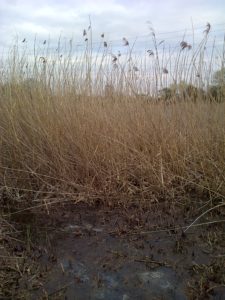
Cut area of Reed in foreground. Note the amount of additional ‘litter’ amongst the dead stems behind. (Photo: Chris Rose)
Two Snipe were flushed whilst getting photos of the area of cut Reed. They have utilised this area over the winter and, as usual, the adjoining shallow zone with rushes and scattered Reedmace stems.
Whilst 7 Harvest Mouse nests were found ‘out of the blue’ in 2014, none were found in 2015. However, three plastic bottles tied to thin bent-over willow stems, and baited with seed, have been placed in the area where most nests had been found. That seed has twice all been neatly de-husked and eaten. Whilst super-agile Wood Mice cannot yet be discounted, this DIY method should allow for ready camera-trap monitoring to see if Harvest Mice are still present once we have new cameras. This species is a ‘coup’ for a site anywhere in London. The intention is to install some more bottles, mounting them on thinner uprights, with only a dead reed stem providing access to the mouth. That should help rule out Wood Mouse.
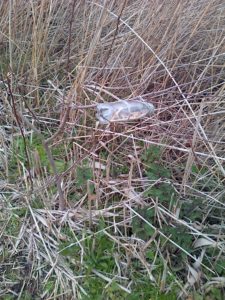
Seed-baited bottles are being used to survey for continued Harvest Mouse presence. Super-agile Wood Mice cannot be ruled out yet, but a refined version, plus camera trap monitoring, should sort this out in the absence of further nest finds. (Photo: Chris Rose)
Star of Bethlehem (Ornithogalum umbellatum) is a bulbous plant, thought to be native in East Anglia, but got to Thames Road Wetland in road embankment gravel, probably as a garden escape. It seemingly disappeared for 3 or 4 years, and I thought it had died out, but there are currently four plants in flower. Unfortunately the petals were not open due to the cool conditions, but the green stripe on the reverse can be seen as a result.
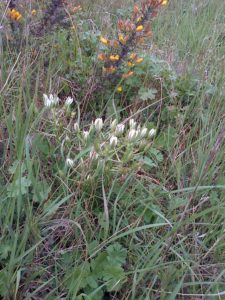
Star of Bethlehem, thought to have died out at the site, has made a welcome reappearance. (Photo: Chris Rose)
Unfortunately there was the usual array of empty beer cans tossed over the bank onto the west end of the site, to clear up before I left. We are asking the Council to install a suitable recycling bin as some of those who hang out here do go to the trouble of leaving their cans in plastic bags at the base of the existing litter receptacle.
Chris Rose. Volunteer Site Manager (for Thames21).

